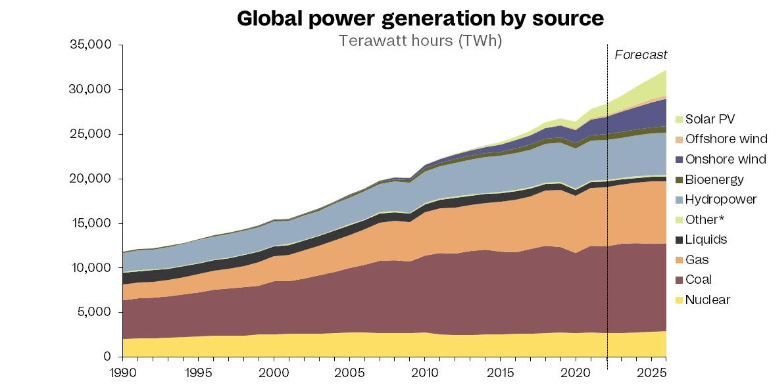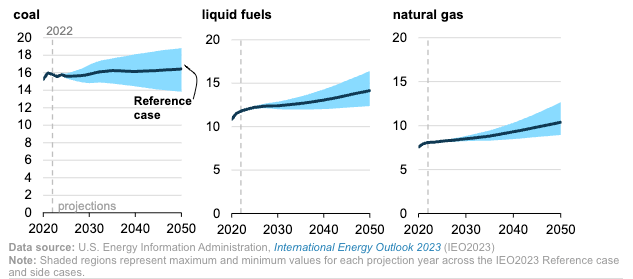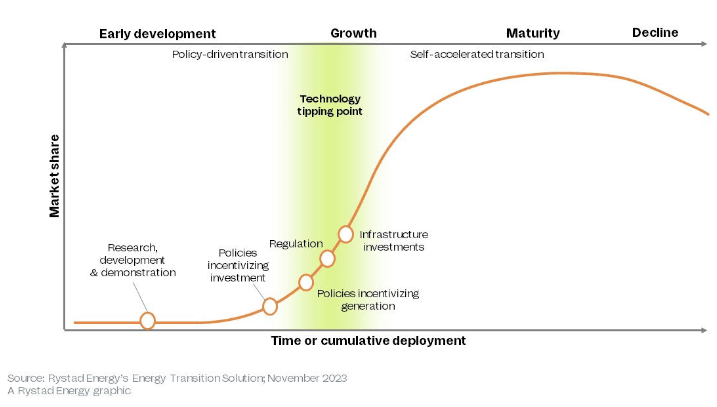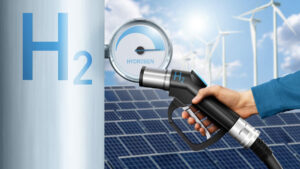Emission Control: It’s all downhill from here for coal power as the renewables era takes flight

Pic: Getty Images
- Rystad forecasts that coal usage and emissions in the power sector has peaked and will start declining in 2024
- Coal starting to be displaced by new electricity supply from renewables
- Some of the 10 steps to accelerate the transition to net zero outlined
2023 could be a watershed year for emissions with Norwegian independent energy research and business consultancy Rystad Energy forecasting that coal usage and emissions in the global power sector has reached its peak and will start declining in 2024.
According to its modelling, new electricity supply from renewables is expected to outstrip power demand growth and start the displacement of coal, which has a dominant role in electricity generation and is the reason why the power sector is the largest contributor to global pollution – accounting for about 40% of all emissions.

Rystad noted that while falling investment in coal capacity and overall usage in Europe and North America had been offset by growth in Asia, the fossil fuel will be gradually displaced by the rapid development of low-carbon power sources.
However, the green lobby might want to hold off on celebrations as the project drop is marginal – a mere 41 terawatt hours (TWh) to 10,332TWh, or just under 0.4%.
“The drop in total coal generation in 2024 may be small on paper, but it signals the beginning of the renewable energy era in the power market,” Rystad senior vice president of renewables and power research Carlos Torres Diaz said.
“However, there are still challenges to overcome in a renewables-heavy electricity sector, including intermittency issues. For that reason, coal and natural gas power plants will continue to play a key role by providing baseload supply and flexibility.”

Further evidence that coal might have peaked comes from the US Energy Information Administration (EIA), which projects global CO2 emissions from coal as remaining relatively flat through to 2050.
While this is less positive than Rystad’s forecast, it is still an indicator that coal’s day has at least peaked.
Taken together, what is clear is that coal’s impact on emissions is finally starting to wane – a rather fitting end for the first fossil fuel to see widespread use.
However, there is still a long way to go before the use of coal goes the way of the dinosaurs as developing countries cling to its use as a cheap way of generating electricity.
China and India, for instance, account for about two thirds of the world’s coal consumption between 2022 and 2050 with India’s consumption expected to double during that time.
10 steps for a faster, more efficient energy transition
Rystad isn’t just content to forecast coal’s decline though.
The energy consultancy has also outlined 10 steps to accelerate the transition to net zero, limit global warming and ensure a clean and reliable energy future.
Some of the notable steps are fast-tracking renewable energy developments, taking meaningful attention on methane and putting a price on carbon.
On fast-tracking renewable energy developments, Rystad says that while the supply chain is primed and ready to expand developments quickly, the rollout needs to be accelerated by shortening permitting times and mitigating short-term financing barriers like high interest rates.
It noted that global renewable capacity needs to increase from about 3.6 terawatts (TW) last year to nearly 11.2TW by 2030 to meet a 1.6-degree global warming scenario.

Reduction of methane emissions is also important as while it makes up to 20% of global greenhouse gas emissions, it is often overlooked in net zero strategies.
Supporting investments in emerging agriculture technologies like cellular agriculture and precision fermentation can significantly reduce emissions from livestock while promoting landfill gas capture and anaerobic digestion can turn these emissions into energy or hydrogen, reducing methane release into the atmosphere.
Australia certainly seems to be on board, committing during the recent COP28 conference to a 30% reduction in methane emissions by 2030.
Rystad also called for a maturation of the value of carbon, saying it is particularly important in hard-to-abate sectors, where a carbon price directly influences the adoption rate of clean technology such as carbon capture, utilisation and storage.
There are seven more steps described by the consultancy but that such steps are even needed just serves to underscore how much activity is still needed globally to meet net zero emissions by 2050.
ASX green energy news
Indonesian focused nickel producer Nickel Industries (ASX:NIC) disclosed its goal of reaching a 50pc reduction in carbon intensity by 2035 and net zero emissions by 2050 at the United Nation Climate Change Conference (COP28) in the UAE last weekend.
Since its IPO in August 2018, NIC has established itself as a global top 10 nickel pig iron producer, recently diversifying into the ‘Class 1’ nickel EV battery supply chain by converting some of its current production into nickel matte.
It also acquired an interest in the operating Huayue Nickel Cobalt high pressure acid leach (HPAL) project (HNC) back in August, one of the first HPAL projects in Indonesia which is being developed by majority owner Huaqing Nickel and Cobalt, a wholly owned subsidiary of Huayou Cobalt.
NIC managing director Justin Werner says the company is implementing the most advanced third-generation HPAL processes with power consumption 70% lower than other HPAL plants and carbon emissions one-tenth of similar pyrometallurgical plants.
“These and other measures, including the adoption of renewable power sources across NIC’s operation to further de-carbonise puts us on track to achieve a 50% reduction in carbon intensity by 2035 and net zero emissions by 2050.”
First of its kind nickel hydrogen battery project in Oz
AGL Energy (ASX:AGL) and US energy-tech company SLB are working together to pilot a nickel hydrogen battery at AGL’s Torrens site in Adelaide with a target installation date set for 2025.
The small 180kW/360kWh, pilot-scale nickel hydrogen battery will be the first of its kind in Australia and is part of AGL’s wider strategy to transition the former gas hub into a new clean energy precinct.
Given their high energy density and long life, nickel hydrogen batteries are widely used in the world today as energy storage in satellites and space probes. The ISS, Mercury Messenger, Mars Odyssey and Mars Global Surveyor are equipped with nickel hydrogen batteries.
AGL’s MOU with SLB will run for up to two years with AGL testing the operational performance of the battery at AGL’s Torrens site, with the battery providing storage for on-site power use.
RIO’s approves solar and battery storage for bauxite operations
Rio Tinto (ASX:RIO) has given the tick of approval for a new 12.4MW solar farm and 8.8MVa/2.1MWh of battery storage to provide renewable energy for the Amrun bauxite operations near Weipa in Queensland.
The 12.4MW solar farm and battery storage are part of Rio’s ongoing efforts to reduce emissions at its Pacific bauxite, alumina and aluminium operations.
They are expected to reduce Amrun’s diesel electricity consumption by 37pc and annual CO2-equivalent emissions by 14,000t, and will add to the existing 5.6MW of solar and 4MWh of battery power built for Rio’s Weipa operations and the local electricity network since 2015.
Another hydrogen deal in the works for Fortescue Future Industries
The green leg of Fortescue (ASX:FMG) is at it again with another hydrogen MOU, this time with global consulting and software engineering group, HTEC, to explore building Canada’s first domestic green hydrogen supply chain and develop off-take opportunities.
Fortescue is proposing the development of a green hydrogen and green ammonia production facility in Prince George following the submission of an initial project description in September 2023.
Under the terms of the MOU, HTEC would off-take green hydrogen from Fortescue’s site to facilitate the growth of the green hydrogen transportation market.
Green energy companies share prices today:
Related Topics

UNLOCK INSIGHTS
Discover the untold stories of emerging ASX stocks.
Daily news and expert analysis, it's free to subscribe.
By proceeding, you confirm you understand that we handle personal information in accordance with our Privacy Policy.








